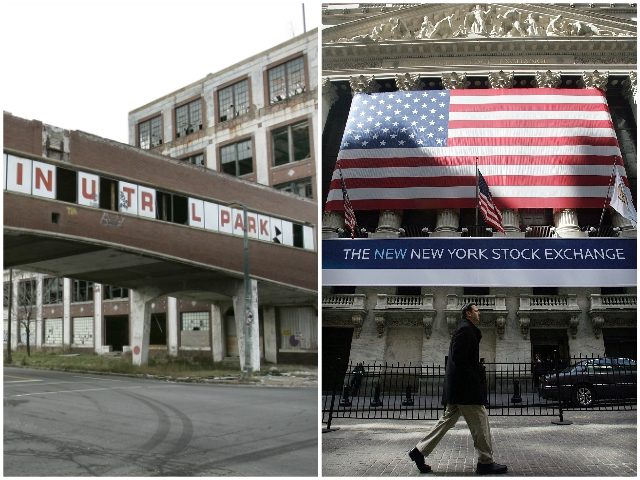A headline in the Wall Street Journal last month put the matter plainly: There are “Two Americas.” One America that gains from globalization, and another, much larger, America that loses from globalization. And as we now know, this cleaving of the nation is not just a matter of economics, it’s also a matter of life and death.
The Journal piece was an interview with the Nobel Prize-winning Princeton University economist Angus Deaton; two years ago, Deaton and his wife and fellow Princeton economist, Anne Case, burst into prominence with a rigorous study on the rising death rate of white Americans. That is, after centuries of mostly steady decline, the white death rate had been rising since the late 1990s.
In fact, the additional deaths among white middle- and working-class Americans—some 488,500, mostly from opioid abuse, suicide, alcoholism and other deadly forms of despond—exceeded the deaths from AIDS in the ’80s and ’90s, when the disease in the U.S. was at its worst.
And yet as Deaton and Case observed, in contrast to the AIDS crisis, this latter plague was a “quiet epidemic.” That is, the mainstream media wasn’t much interested in what was happening in the heartland, nor was the popular culture, nor was, even, the political class—including those politicians who were supposed to be representing those afflicted areas. So there were few vigils, no quilts, no Broadway plays—not much of anything, except sorrow. Indeed, even now, a scan of the headlines and top stories reveals that this epidemic doesn’t trouble the big media hubs.

A billboard advertising treatment for opioid addition stands in Dickson, TN, on June 7, 2017. More than 2 million people in the U.S. are hooked on opioids. Overdoses from these drugs have killed more than 300,000 Americans since 2000, and they are killing an average of 120 people every day. (AP Photo/David Goldman)

Kyle Graves, who is in recovery for opioid addition, sits in the home he shares with his mother in Franklin, TN, on June 7, 2017. He was first prescribed oxycodone for degenerative arthritis. When he lost his job as a car dealership finance manager, he found the pills helped get him through that crisis, too. He was a functioning addict when his sixth child was born, a boy named Joshua Jeremiah who contracted spinal meningitis during childbirth. The infant clung to life for six weeks; his death sent Graves sinking deeper into addiction. (AP Photo/David Goldman)
Still, awareness is growing; just on Sunday, the White House issued a report indicating that the cost of the opioids epidemic for just a single year, 2015, was $504 billion. That estimate was mostly the direct cost of, and the loss of output from, the 33,000 Americans who died of overdoses that year, and yet it also included the costs of treatment for non-fatal incidents.
As Deaton told the Journal, “Bad things are really happening, and they’re continuing to happen.” Detailing his and his wife’s research, he added,
We dug down a lot more into the educational differences and found that it is very much a two-Americas situation, where people with bachelor’s degrees are doing pretty well and those without them aren’t doing very well at all. . . . Sustained increases in mortality for any major group in any society are really quite rare. It’s an indication that something is very wrong.
In particular, Deaton pointed to the abusive skyrocketing of OxyContin, a drug that didn’t even exist until 1995, when it was released by Purdue Pharma. That company has racked up quite a record—a record, that is, of massive profitability amidst mass lethality. As a detailed account in The Guardian noted recently:
From 1996 to 2002, Purdue more than doubled its sales force and distributed coupons so doctors could let patients try a 30-day free supply of these highly addictive drugs. Prescriptions issued for OxyContin in the US increased tenfold over those six years, from 670,000 a year to more than six million.
It’s important to acknowledge that what Purdue did was legal, or mostly legal; the company was fined $600 million in 2007, although that fine was a pittance compared to its OxyContin profits. And in any case, legality is not the same thing as morality.
As a 2009 bulletin from the American Public Health Association headlined, “The promotion and marketing of OxyContin: commercial triumph, public health tragedy.” Just in October, The New Yorker magazine described Purdue’s owners, the Sacklers, as “the family that built an empire of pain.”
So there we have it: A corporation and its owners made billions, and hundreds of thousands of people died (Note to those libertarians who wish to decriminalize, or even legalize, drugs: This is what you’ll get. That is, some of the smartest chemists in the world will be teaming up with the wiliest marketers to produce products that will turn people into addicts and, possibly soon thereafter, corpses).
Yet finally, a few populist heroes are now willing to fight these corporate emperors of pain. In May 2017, Ohio Attorney General Mike DeWine, a Republican, filed suit against Purdue and four other drugmakers for mass-producing misery and mortality. As DeWine said:
These companies got thousands and thousands of Ohioans–our friends, our family members, our co-workers, our kids–addicted to opioid pain medications, which has all too often led to use of the cheaper alternatives of heroin and synthetic opioids.
And others, too, have filed lawsuits. Good.
Yet Deaton believes that combating opioids, important as that might be, is not enough. As he told the Journal, the drugs are just the symptom; the root cause, and thus the real disease, is economic collapse:
If you’re digging into what the underlying causes are, we are beginning to speculate about working-class whites possibly having the pillars that held up their lives beginning to crumble.
And what pillars were these? Deaton’s answer included such familiar-sounding points as “having a job with a ladder up,” and “having job where you could actually ask a woman to marry you and she would marry you.” In other words, the basic building blocks of a stable life—a job with prospects for upward mobility and a family to bolster personal stability.
If those points seem to be familiar clichés, well, that’s because many clichés have, in fact, a firm basis in reality. It doesn’t take an expert to see that if young people don’t earn enough to move away from home and strike out on their own, they are a lot less likely to form a serious relationship with either work or another person. And it’s that lack of attachment that often leaves people defenseless against the impulse toward unsafe behavior. We can add that this is Conservative Wisdom 101; people crave the security of sturdy order—and if they can’t get it, they’ll crave something else.
So what to do? Among Deaton’s suggestions was a restoration of the “social contract.” That is, the basic positive relationship between people and society, starting with a good job that pays good wages. That’s how one gets going on the American Dream.
And yet as many Americans have discovered—and this is another story that the MSM was never much interested in, especially not during the Clinton and Obama years—it’s a fact that wages for many have been flat for most of the last half-century.
This is a change from the historic American pattern. In fact, not that long ago, before the vast inflation of real estate prices in many areas, a short-order cook could reasonably expect to buy a house and support a family. But today, what are the prospects for a Starbuck barista?
For his part, Deaton cites various factors in the waning of wages, including the erosion of the minimum wage, and also the rise of non-compete clauses, which have the effect of locking in working stiffs, not just hotshots. As a Baltimore Sun headline explained earlier this year, “Employers use non-compete agreements even for low-wage workers.”
Deaton also added a factor that’s been nearly forgotten—labor unions:
Many people have mixed views about unions, but unions used to give people some measure of control at work. They gave them a social life and political representation in Washington, which doesn’t really exist anymore.
Yes, as Deaton conceded, labor unions have their share of detractors, including many, if not most, Republicans. And yet it’s hard for Americans of any party not to notice that the collapse of private-sector unionism—from more than a third of the workforce after World War Two to around six percent today—has coincided with the flattening of wages and the increasing of pathologies. So if one hates unions, one must then find other ways of raising incomes. If not, the deaths, and other ills, seem destined to continue.

Weeds grow in the parking lot of the closed Culp Weaving plant in Burlington, NC, on June 8, 2009. The upholstery giant moved to China to take advantage of cheaper labor. (AP Photo/Jim R. Bounds)

Vacant land and a huge concrete slab is all that remains of the 130-acre General Motors auto plant complex known as Chevy-in-the-Hole in Flint, MI, on April 8, 2009. At its peak, the factories employed thousands. Now, all but one of the 20 factories and buildings in the industrial valley have been closed and torn down. (AP Photo/Carlos Osorio)
Some will say that part of the problem of flatlining wages, of course, is that economic growth has been slow. And that’s true: In fact, growth was much higher in the ’50s and ’60s than it has been in the decades since. And yet growth hasn’t been that slow: Today, the GDP of the nation is $19.5 trillion, more than double what it was two decades ago. Indeed, that much GDP works out to about $60,000 per person. That’s not per worker, that’s per person.
So the question arises: Where has all that money gone? The quick answer: That wealth is now in the hands of very rich Americans, and also in the hands of foreign workers.
Here at home, according to the U.S. Federal Reserve, the top one percent now control 38.6 percent of all the nation’s wealth, and the top ten percent now control most of the rest. In the meantime, the bottom nine-tenths have less than 23 percent of the wealth, down from 33 percent three decades ago.
One needn’t be any sort of class warrior, nor an income redistributionist, to see that there’s something wrong with this picture. That is, if we’re to have a united country, in which Americans from the bottom 90 percent undertake the burden of all the hard work—virtually all the key civic duties of soldiering, policing, and firefighting, for example—then we’re going to have some more equity as to incomes and wealth.
Virgil hastens to add that this is not an argument for tax increases. As we all know, raising taxes tends to make the D.C. Swamp even swampier. The goal shouldn’t be to put more money in the hands of Deep State bureaucrats, nor of their Beltway Bandit contractor-cronies; instead, the goal should be to empower private-sector workers to demand higher wages from their private-sector employers.
Yet on that score—the power of workers to carve out a bigger share of the pie—the biggest inhibiting factors have been immigration and trade. That is, if U.S. employers have the option of bringing in cheap labor from other countries, or of moving their production offshore, well, then, American workers have lost their leverage.
The fact that immigration undercuts wages at the low end is well understood by now. And yet what hasn’t been so well understood is that outsourcing is undercutting wages even at the relatively high end. That is, it’s not just blue-collar workers who are losing their jobs to China, South Korea, and India; it’s also white-collar accountants, technicians, engineers—and even doctors.
And that’s all because of the ideology that supports outsourcing, namely, globalism. As Breitbart’s Stephen K. Bannon has said, “The globalists gutted the American working class and created a middle class in Asia.”

Former chief strategist to President Donald Trump and executive chairman of Breitbart News Steve Bannon speaks to voters in Montgomery, AL. (Scott Olson/Getty Images).
Yes, that’s the truth. A key document for understanding this reality is a 2016 study from the Massachusetts Institute of Technology, “The China Shock: Learning from Labor-Market Adjustment to Large Changes in Trade.” The study proves that the detrimental impact of China trade on U.S. workers has been profound. The authors note that China’s share of global manufacturing rose eight-fold from 1990 to 2012, and that among the consequences of this export-surge has been the loss of 560,000 American manufacturing jobs, and counting. As the MIT authors put it:
Improvements in China’s productive capabilities and reductions in its trade costs will [lead] to a contraction of industries subject to greater import exposure.
Indeed, we can add that the further reverberations—in terms of lower wages, lessened industrial muscle, and weakened national security—are far greater than just the job losses. And those other academic authors, Deaton and Case, would add that the ultimate wages of low wages are… demoralization and death.
To be sure, not every American is suffering because of the China trade. The rich—those with capital and/or a connection to the global economy—are doing just fine; they’re the ones who do well when the American supply chain becomes, instead, the global supply chain.
Thus we see the Two Americas: First, there’s one tiny part, mostly in the coastal clusters, getting richer, and more arrogant. And then there’s the other, larger part, mostly in the middle, growing poorer—and angrier.
It’s hard to believe that the larger part of America will allow this painful process to continue for much longer. The goal for all Americans should be, of course, One America.
Yes, that’s the goal.

COMMENTS
Please let us know if you're having issues with commenting.